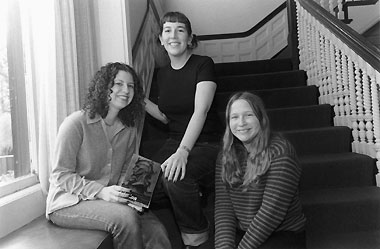![]()
Departments
![]()

|
Week of 19 November 1999 |
Vol. III, No. 15 |
Feature
Article
A Clarion call
Dogged initiative propels new student literary magazine
By David J. Craig
One of the first things Josette Akresh did as a BU freshman in 1997 was scour the campus for a student literary publication. She'd been poetry editor of a student magazine at her Scarsdale, N.Y., high school and planned on picking up where she left off while majoring in English here.
|
|
|
Clarion is a literary arts
magazine written and produced by BU students that
will be available free at the CAS English
department and the GSU Link in early December. It
contains poetry, prose, and visual art by 32
undergraduates.
|
Determined to have a professional product, Akresh and her friends posted flyers soliciting submissions around campus and visited local businesses to try and develop an advertising base.
The result, two years later, is Clarion, a 60-page, paperback-size magazine that features the work of 32 BU students. Submissions range from confessional free-verse poetry to surreal prose to some downright spooky pen-and-ink drawings. Copies of the December 1999 Clarion will be available free at the CAS English department and at the GSU Link next month.
"I can't believe how much this has grown," says Jennifer Herron (CAS'00, SED'00), Clarion's original editor-in-chief. "For the first issue, the magazine didn't even have a name. It didn't have much meat to it, and I designed it myself, so it looked really bad."
From the ground up
Indeed, BU's student literary publication got off
to a rough start. The spring 1998 issue of ? -- it used a
question mark for a title, reflecting its publishers' lack
of direction -- was scrappy at best, made of stapled
photocopies and containing writing mostly by its editors.
The shaky send-off was partly a result of unrealistic
ambitions: the original concept was a full-color New
Yorker-style magazine that would appear three times a year
and cover just about every art-related event at BU,
including long features on local exhibitions, readings, and
artists. With little idea how to attract advertisers or
secure BU funds, the magazine's staffers, who lacked a
faculty advisor, knew they were in over their heads.
"We had no idea we could go to student government to get money," says Akresh. "I was a freshman, Jen had just transferred from Northeastern, and we were making it up as we went along."
Whatever the shortcomings of ?, the next issue -- published in March, 1999 as Clarion -- was impressive. The group had learned how to acquire BU funding: after registering with the Student Activities Office as an official student group, called Students for Literary Awareness, members raised more than $1,000 by petitioning organizations such as the Student Union Allocation Board and the Student Union Senate.
Clarion's staff also solidified a relationship with Bostonia, BU's alumni magazine, receiving some funding and help producing the publication, and eventually acquiring a small office space. In addition, the editors had some outstanding submissions for their sophomore effort, which was a useful marketing tool in soliciting backing for the upcoming issue.
Building a future
The goal of Clarion's organizers was always to
create a biannual publication that would outlive their own
college careers. "It would be great to someday have a link
on BU's Web page, and students could see it as a prestigious
journal to contribute to," says Akresh. "That's why I think
it's important to have the stability that an underground
publication wouldn't have. It's important not just to get
yourself published, but to get published in a credible
publication."
|
|
|
Clarion editor-in-chief Josette
Akresh (CAS'01) and editorial board members Erin
Gumbel (CAS'01) and Deena Salzman (CAS'01) (from
left) hope that the student literary arts magazine
that they helped launch will continue to flourish
after they graduate. Photo by Vernon Doucette
|
The content for the November issue was selected from 200 submissions from 54 students, few of whom Clarion's editors know personally. The cost to print 3,000 copies of Clarion is $2,800, with about a quarter of the funds coming from the CAS Forum, a quarter from Bostonia, and the rest from various student groups and private donations.
Erin Gumbel (CAS'01), Clarion's secretary, says the new open editorial policy lured her to the group. "It's hard to get interested in some student activity if you feel that it's run by one group of friends and your opinions aren't going to be taken seriously," says Gumbel. She adds that soliciting funding for Clarion gave her an education in networking. "That's why I decided to get involved in this."
For Akresh, who spends more than 15 hours each week editing poetry, getting estimates from printers, and meeting with Clarion and BU staff members, publishing a magazine also initiated her into some of the realities of the publishing business.
"A lot of the writers have a real problem with being edited, but BU told us that we had to take out some stuff that had overt sexual content," she says. "I've come to accept that as the way of the world. I would like to be the person choosing what is offensive and what isn't, but I understand."

